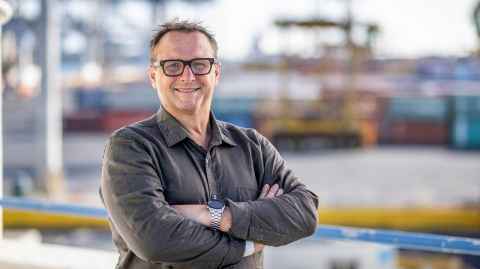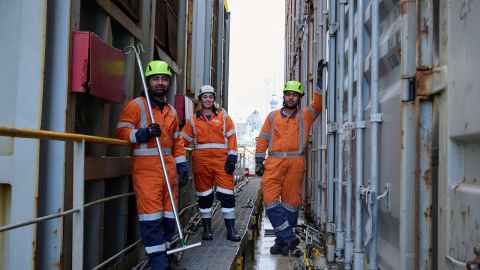From turmoil to triumph: how HPHE turned Port of Auckland around
Phil Doak, GM People, Legal and Communications at the Port of Auckland, highlights the genesis, key aspects, and impact of the adoption of a new approach to engagement at the Port.

A few years ago, Port of Auckland was in a state of crisis. The headlines painted a clear picture — workplace fatalities, automation failures, poor workplace culture, disastrous industrial relations, and an openly hostile relationship with its shareholder, Auckland Council, led the news. For a critical national asset, it was a shipwreck in slow motion.
Today, Port of Auckland is back on course. Profits are up, injuries are down, the culture has been reshaped, and once-warring factions—unions, management, and council—are now working together. The engine behind this extraordinary turnaround? A humanistic, principles-based approach called High Performance, High Engagement (HPHE).
Welcome to the new Port of Auckland: where workers aren’t just consulted—they’re trusted. Where unions don’t just negotiate—they innovate. Where performance doesn’t come at the expense of people—it’s driven by them.
A legacy of failure
Let’s not sugarcoat it: by late 2021, the port was a case study in dysfunction. An automation project had spectacularly failed. Health and safety was in crisis. Industrial relations were hardened. Morale was at rock bottom.
Even Auckland’s Mayor at the time didn’t mince words when reflecting on the port’s past: “The relationship between the port and the Council was appalling. There was no confidence in management… it was a disaster.”
The culture was top-down, adversarial, and hierarchical. The kind of place where decisions were imposed with minimal consultation. It wasn’t just failing commercially—it was failing as a community.
Enter HPHE: A human-centred revolution
High Performance, High Engagement (HPHE) isn’t your typical corporate transformation toolkit. It’s not a new software suite, theory from a book, or Agile. It’s a shift in mindset to radical collaboration, inclusion, transparency, consensus-seeking, and empowering those closest to the problem to solve it.
Roger Gray started as CEO in March 2022 and brought HPHE in with clear intent: to rebuild not just a port, but a people-powered institution.
“This wasn’t about slapping on a few values posters following an engagement survey or a new HR strategy,” Gray said. “It was about inviting our people into the heart of the business—giving them real agency to shape the future of the port. We had to rebuild trust, brick by brick. Culture was at the heart of our strategy.”
And that trust wasn’t earned by edicts from above. It was forged in collaborative forums, tough conversations, and a commitment to stakeholder involvement and Interest-Based Problem Solving (IBPS) - the practical engine that powers HPHE. IBPS puts problems on the table and invites everyone—union reps, crane drivers, health and safety staff, executives to unpack them together, not to win, but to understand and solve. Those most impacted are involved in crafting the solution.
Unions at the table, not on the sidelines
For the Maritime Union of New Zealand (MUNZ), HPHE represented a sea change. MUNZ Local 13 Secretary Grant Williams, once a fierce critic of port management, now describes the shift with cautious optimism—and unmistakable pride.
“We’ve gone from fighting to collaborating. And not in some tokenistic way—this is real,” Williams said. “We’re part of the decision-making now. HPHE isn’t anti-management or anti-union. It’s about being pro-solutions.”
This change didn’t happen overnight. It took deep listening, a willingness to acknowledge past failures, and a bold new social contract between labour and leadership.
And as you’d expect there was some initial resistance to the radical collaboration approach of HPHE. Some good people in management left the business. Many leaders, union reps and employees initially doubted how it would work, but once it began, the momentum of positive change was undeniable.
Some of the successes? New shift structures that improved work-life balance for frontline workers and efficiency for the business, and better safety through the creation of an Approved Code of Practice for Stevedoring, which had both been issues for years were solved collaboratively, and quickly.

A culture transformed
But something deeper also changed. People at all levels started to speak up, not just when asked—but because they knew they’d be heard.
“We had to become vulnerable as leaders,” Gray said. “That’s scary in a performance-driven business. But it’s also where the magic happens. When people see that you’re listening—not just nodding—but genuinely taking their ideas seriously, they show up differently.”
One frontline worker who had been at the port for over 25 years told internal HPHE facilitators, “This is the first time anyone has ever asked me what I think we should do.”
The port’s safety record also tells the story. In the last 36 months, there’s been a marked reduction in the number of injuries, but also the severity of those incidents. That’s not because of new rules, but because of new relationships - where workers co-design safer processes alongside management, with lived experience guiding every solution.
Results you can count (and feel)
Let’s talk numbers. Since HPHE was adopted:
- Profitability has increased significantly. Underlying net profit after tax has increased from $25.2m in FY22 to $55.2m in FY24 with a stronger underlying NPAT expected to be announced for FY25 later this year.
- Employee engagement increased dramatically from 58% in 2020 to 73% in 2024.
- Productivity has increased—and not because workers are being pushed harder, but because they’re working smarter together. Average weekly TEU container moves have increased from 11,000 in 2022 to nearly 17,500 TEU today.
- There has been no industrial action and legal fees are minimal.
Even Auckland Council has taken notice. Once a vocal critic, the city’s Mayor is now one of the port’s strongest advocates.
“This is what good governance and leadership looks like,” he said recently. “They’re making money, they’re keeping people safe, and they’re actually listening to the city they serve. Frankly, it’s inspiring.”
Why HPHE worked at the port - and could work anywhere
Port of Auckland proves that HPHE isn’t just theory. It’s a practical model for transforming culture and performance in tandem. But it only works when leadership is willing to give up control, and when the unions and labour are willing to step into responsibility.
HPHE works because it respects the intelligence and experience of unions and frontline workers. Management do not have the monopoly on good ideas. It recognises that solutions aren’t found in ivory towers, but on wharves, in tugs and in the messroom. It taps collective knowledge.
Perhaps most importantly, it works because it’s rooted in shared interests, not opposing positions. That’s the quiet genius of it: it replaces battles with dialogue and entrenched power with co-created progress.
The port’s transformation is a blueprint for any organisation trying to break out of the zero-sum logic of past industrial relations.
But it takes leaders with courage, and a belief that humans, not hierarchies, drive performance. It requires strong leaders in management and in the unions who believe in a different way and who are prepared to walk away from their differences and focus on their shared interests.
Grant Williams sums it up best: “We’re not perfect. But we’re talking. We’re solving problems together. That’s a revolution, actually.”
At Port of Auckland, HPHE has become the way we work.
The challenge to unions and business leaders across the supply chain is this – why wouldn’t HPHE and a people-centred transformation work for your organisation too?
If Port of Auckland and the wharfies can come together after generations of conflict, why can’t you?
Phil Doak is GM People, Legal and Communications at the Port of Auckland. He can be contacted at philip.doak@poal.co.nz.
Note: Port of Auckland are in the process of making their HPHE information publicly available. Keep an eye on their website for more information.